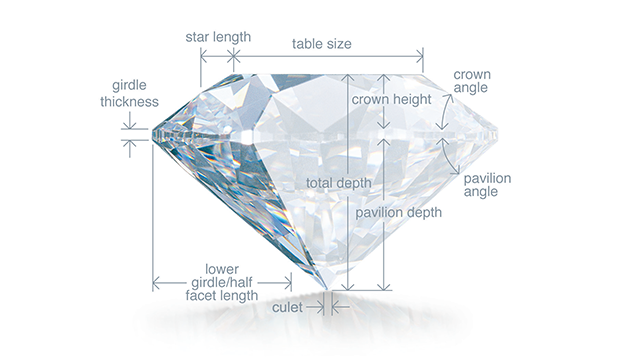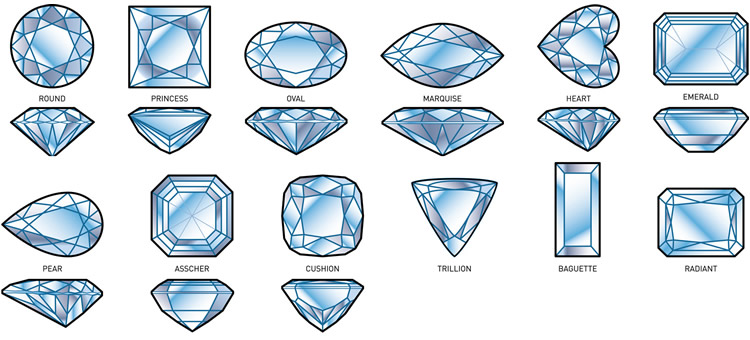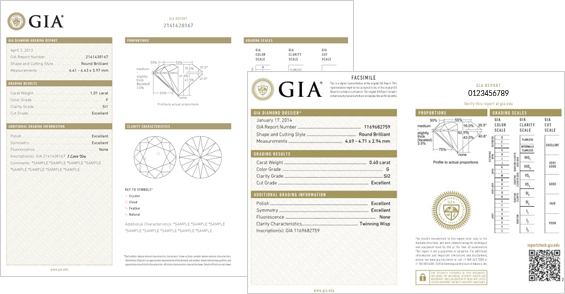Diamonds are the hardest gemstone of all natural material. It is something superb and lustrous. At its purest state, diamond is colourless. Diamonds are not just colourless, but other colours are very rare, expensive and unique. However, colourless diamonds are the most common and popular.
For special occasions like engagements, marriages and anniversaries, diamonds are used to represent the commitment to everlasting love. Today as throughout the centuries, the tradition of giving a diamond ring as a token of love still continues to symbolise the purity, strength and eternity of one's love from the heart.

According to the international standard, there are 4 C's which determine the diamond's value; Colour, Clarity, Cut and Carat Weight. We provide you with additional 1 C's which is Certificate (genuine gemological report). It is considered as important when purchasing a diamond.

Diamonds are available in a variety of shapes. Internationally, the most popular of the diamond shapes is the round brilliant. The exquisite engineering of this diamond maximizes the return and play of light that makes the sparkle of a diamond what it is. This preference for the round brilliant cut is followed closely by the square or princess cut diamond. The scintillating beauty and the play of light through these wonderfully and exquisitely cut diamonds is the reason for their enormous and continued popularity. For those who prefer a more angular diamond the emerald cut is perfect. The rectangular step-cut that is the standard of this wonderful diamond provides its unequaledshine. Always, our ability to meet your diamond needs means that any diamond shape will be available for your consideration.

A diamond’s color is measured against a series of masterstones. While most diamonds are colorless to slightly yellowish, the most sought after diamonds are in the colorless or near colorless range. A “D” graded diamond is at the top of this grading range. Many and most beautiful diamonds are found from this letter grade through letter “H” on a scale that runs to the industrial type diamonds the furthest down the scale in the “Z” range.
Diamond color occurs naturally in a wonderful array of colors from the champagnes or light brown, to striking yellow, pink, purple, blue and red.
These colors are known as “fancy” and generally are available by special order.
Certain diamonds contain fluorescence which reacts in "black light". This fluorescence can range from nil to strong. This characteristic of a diamond is also measured and graded.

Clarity of a diamond refers to how free of natural characteristics a diamond is. In gem-quality diamonds the sometimes minute internal and external characteristics will determine the clarity of the diamond. Most diamonds will have some degree of natural inclusions. The scale used to measure these characteristic takes into account the size, number and placement of the inclusions. The clearer a diamond is to the naked eye and more under the scrutiny of a loupe, the more valuable the diamond.

The brilliance and fire of a diamond is largely determined by the cut of the diamond. The proportions that determine the optimum scintillation vary with each diamond shape. Finish refers mainly to the symmetry of the cut. The cut of the diamond is the primary reason a diamond sparkles the way is does. That sparkle and flash of light is what it is because of the play of light within the different facets that are found within the diamond.
The “ideal” proportions (depth and width) of diamonds varies with the different shape of the diamonds.

This is the most preferred cut. Its finest details are usually invisible to an untrained eye.
Our precise craftmanship creates the pattern of a series of eight arrowheads in the diamond with the use of an H&A's scope. If the diamond is turned up-side-down, you will see a perfect pattern of eight heart shapes. These unique features are one of the few easiest ways to analyse a diamond.

A carat is the measurement in points that defines the weight of a diamond. 100 points equals a one carat diamond. A carat weight of a single diamond is usually shown as Ct. The carat weight of more than one diamond (as in a tennis bracelet) is usually written as carat total weight written as ctw. or cttw.

What is a Certified Diamond?
We provide diamonds certified by either of two top diamond grading companies, The Gemological Institute of America (GIA) or European Gemological Laboratory (EGL). Diamond certification insures that the diamond you are considering has been appraised by an outside entity. Certification is often suggested when insuring the larger center or main diamond of your ring, earrings, pendant or bracelet.
Diamond certification highlights the many attributes of a given diamond. Certification diagrams the proportions of the cut of the diamond, the color, clarity, and carat weight of it as well. It also mentions addtional grading information in terms of the finish (polish and symmetry) of the diamond and whether the diamond is laser inscribed. It defines the measurements of the diamond, its shape and cutting style and whether the diamond has outstanding additional information unique to it.
Certified diamonds are issued a registry number by the certifying lab that is unique to the individual diamond. This number appears on the report and can be laser inscribed on the diamond as well. Not all certified diamonds are laser inscribed.
How is an Appraisal Different from Diamond Certification?
We offer our customers a written appraisal for any Diamond or Gemstone purchase. This appraisal unlike the Diamond Certification which is only about a single diamond takes into account the entire piece of jewelry. An appraisal lists additional gems or diamonds that make up the piece as well as how the piece is designed and in what type of metal. An appraisal assigns a monetary value to the jewelry. This appraisal is recommended when the jewelry is to be insured. An appraisal is often required in addition to the certification for purposes of replacement valuation. Appraisals should be updated every three years to reflect the increasing value of the diamonds and/or gems. Appraisals are often accompanied by a photo of the jewelry.
